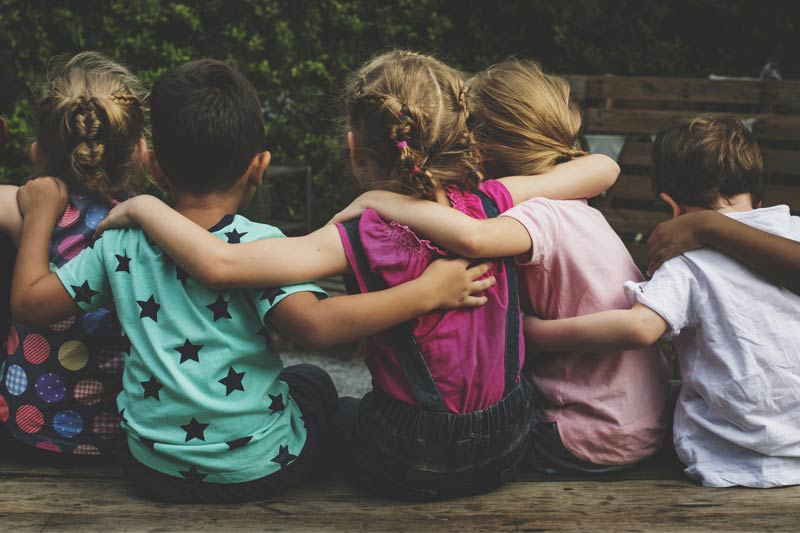“Walking with a friend in the dark is better than walking alone in the light” (Hellen Keller).
It was in my seventh year of secondary school, and I was about to experience firsthand the almost physical pain that the loss of a good friend can inflict. Out of all the girls in our class, Mary and I had connected on every level of our shared affinities, right from the early school days. We shared the same desk and a vibrant passion for books. If you ever saw one of us alone, it was just as unusual as not hearing us discuss the books we read during the perpetually too-short recesses. I was convinced that her reading portfolio was more extensive than mine, adding a healthy dose of respect to the undivided affection I had for her. Because she loved mathematics, a subject that ruthlessly confounded me whenever our paths crossed in the weekly schedule, my respect had taken on epic proportions. Evidence thereof was the fact that I was willing to spend some of our precious breaks solving an algebra problem that intrigued her, even if it could have remained unsolved for eternity from my perspective.
After a summer vacation with many experiences to share, in the gentle September light, I paced the schoolyard slowly, a bag filled with news that begged to be shared slung over my shoulder. However, she didn’t utter a word about the news that would mute all the joyful strings of our reunion. The shock came without warning, the moment the school principal curtly announced that she could move to the school where she was now enrolled as a student by her parents who had requested a transfer. There wasn’t time for any goodbyes, and in any case, the news had nullified any reaction. I was intimately familiar for a long time with the piercing pain that had settled in my stomach, trickling down under my ribs. Mary gathered her belongings and silently left through the door, taking with her all the stories, the starry sky of our daily encounters, and the little fondness I had for the exact sciences.
At the age of 11, I was living through the drama of losing a friend, but even before the pain of separation had completely subsided, I already knew that I was on the winning side. Having shared six years of school and extracurricular joys and sorrows was a memorable experience.
The role of friendship in an adult’s life (as well as that of a child) is frequently underestimated, although the benefits that come with it are substantial, experts say. During preschool years, friendships promote the development of social and emotional skills, enhancing the sense of belonging and reducing stress, says psychotherapist Lena Aburdene Derhally in an article for The Washington Post.
Paul Schwartz, psychology professor and expert in child behaviour, details the social skills that develop within a circle of friends “such as being sensitive to another’s viewpoints, learning the rules of conversation, and age-appropriate behaviours.” He emphasises that friends have a positive impact on academic performance and simultaneously serve as a protective barrier against a child being victimised by peers. “More than half the children referred for emotional behavioural problems have no friends or find difficulty interacting with peers,” Schwartz says.
Because friendship represents one of the potent forms of attachment, the dissolution of such a relationship causes us distress. Psychologists say that the impact of losing a good friend is comparable to the end of a romantic relationship, requiring approximately six weeks for us to readjust to a reality from which the beloved person is now absent.
Throughout childhood and adulthood, we both lose and gain friends, and the fact that the breakup of such relationships emotionally marks us is an indication that friends hold a significant place in the economy of our lives, despite these relationships having fallen into the background in modern society.
They don’t occupy an official niche in society, says William Rawlins, an expert in interpersonal relationships, pointing out that while we’ve found a place for Valentine’s Day, we haven’t designated a Friendship Day in our calendars. Most formal education frameworks fail to include information about managing friendships. Moreover, the sympathy we receive when a romantic relationship ends is generally denied when the subject of loss is “just” a friend, says Liz Pryor, author of the book What Did I Do Wrong? What to Do When You Don’t Know Why the Friendship Is Over.
Nevertheless, the positive news coming from studies investigating the role of friendship in our development and well-being urges us to reevaluate this dimension of our lives on a real scale.
The path to health passes through our friendships
Highlighting the undervalued role of friendship in our lives, Rebecca Adams, a sociology professor at the University of North Carolina, describes a somewhat perplexing scientific reality. While studies predominantly focus on family and romantic relationships, friendships tend to occupy a peripheral place in researchers’ attention, even though substantial sample studies show that “friendship has a greater impact on our psychological well-being than family relationships.”
While family or kinship relationships can be negative or monotonous, friendships are the result of a conscious choice, says William Chopik, a professor at the University of Michigan. On the other hand, we tend to rid ourselves of toxic or superficial friendships, a less convenient triage when it comes to family. In our connections with friends, we are good listeners, provide support, and prove to be trustworthy, says Chopik. In other words, we exhibit precisely those qualities that could bring more harmony into the family if we were willing to use them in relationships within that sphere. There shouldn’t be a competition between the two types of relationships since each contributes substantially to our well-being.
The conclusions drawn by William Chopik stem from an extensive research endeavour (comprising two sets of studies) that he coordinated and which was published in April 2017. The first study delved into the lives of nearly 300,000 individuals aged 15 to 99, hailing from over 90 countries. This revealed that those who prioritised their relationships with friends were healthier and happier, particularly in their senior years. The second study, conducted over a six-year period, tracked 7,481 individuals aged 50 and above, questioning them about the chronic illnesses they faced. Those with a reliable network of friends recorded lower rates of cancer, diabetes, or cardiovascular diseases. The study underscored that the positive effect of support from close friendships exceeded the impact of family support.
Moreover, a meta-analysis in 2010, led by Julianne Holt-Lunstad, a psychology professor at Brigham Young University, scrutinised data from 148 studies involving over 308,000 participants. This revealed that individuals surrounded by friends increased their chances of survival by 50% during the seven-year monitoring period. In essence, they achieved benefits comparable to those gained by quitting smoking.
Considering the health and happiness benefits they bring, it’s quite strange that studies on friendship remain the Cinderellas of relationship studies, says Chopik, while Julianne Holt-Lunstad expresses hope that the value of friendship will receive broader recognition, both from the medical community and public opinion. We still don’t know the mechanisms through which strong social connections influence our longevity, health, or emotional well-being. This is entirely understandable, says Bert Uchino, a psychology professor at the University of Utah, as, beyond theories circulating in the 1970s, we have evidence of the relationship between health and psychosocial processes only in the last 10-15 years.
Although it’s unlikely that, in the near future, doctors will prescribe, alongside diet or medication, more frequent outings with friends, it would be expected that the positive impact of these relationships will reshape our usual agenda, convincing us to place them in the priorities section.

Where do the relationships of yesteryear end up?
It’s not easy to define in one sentence the society we live in, but Juan Díez Nicolás and María Morenos Páez, authors of the study “Loneliness in Spain,” manage to capture its essence, stating that we are marching towards a “society of loneliness.”
The authors analyse data provided by the National Institute of Statistics, noting that, in 2014, there was only one person living in 24.8% of total Spanish households, and the number of these households had increased by 6% compared to the previous year. People not only live alone but also increasingly feel an acute sense of loneliness. According to the same study, 1 in 10 Spaniards says they often feel lonely.
The French are not doing well either when questioned about social relationships, and a survey commissioned by La Fondation de France revealed that loneliness has not been exclusively associated with the elderly for some time now. The study, focused on the age group of 15-30 years, revealed that 6% of young people feel isolated and do not belong to any social network, while 12% stated that they cannot rely on either a family network or one consisting of friends, neighbours, or colleagues.
Americans have also narrowed their social contacts. A study conducted by sociologists from Duke University and the University of Arizona in 2006 showed that the average number of confidants for an American decreased from three to two people in just two decades (1985-2004). The number of those who have no one to share personal details with tripled in the same period.
Loneliness is wreaking havoc in the United Kingdom as well, affecting young people even more than the elderly: 65% of young people aged 18 to 24 said they feel lonely at least some of the time, and 32% have this feeling almost permanently, compared to 32% and 11% of those over 65, who described their loneliness as occasional or continuous, respectively. While 18% have two or three close friends, 1 in 8 British adults doesn’t even have a person they can consider a friend.
Chris Sherwood, the CEO of the charitable organisation Relate, says that relationships are at the core of everything we do, whether as individuals or as a society. Therefore, while we navigate between family and career, it’s crucial to remember that social relationships are the backbone of our well-being. Consequently, it’s worth dedicating time and effort to initiating and preserving friendships.
As we delve into the causes of the increasing fractures in the foundation of our friendships, it is useful to bear in mind the two elements stated by Sherwood—time and effort. They may not have the allure of magical potions, but they have become as essential as they are scarce in the economy of an endlessly congested schedule.
An X-ray of friendship in modern society
In 1994, following a series of interviews with middle-aged Americans about their network of friends, William Rawlins, an expert in interpersonal communication and a professor at the School of Communication Studies at Ohio University, captured the dissonance between how people defined friendship and their habitual behaviour. While most interviewees understood friendship as the readiness “to be there” for each other, they admitted not allocating enough time even to their closest friends.
Data collected from 177,000 individuals and analysed in a meta-analysis in 2012 indicated not only that friendship networks change over a lifetime but also that they have experienced a decline over the past 35 years.
Taking stock of the changes in American society, from the increase in life expectancy to a divorce rate of almost 50%, Beverley Fehr, a social psychologist at the University of Winnipeg, argues that we have never needed a network of friends more than we do now.
If something has changed in recent years, it’s not the expectations we have of our friends, says Rawlins, emphasising that, between the ages of 14 and 100, the people he interviewed considered a friend to be “someone to talk to, someone to depend on, and someone to enjoy.” While our expectations have remained within these parameters for decades, the conditions under which they can be fulfilled have changed.
At 25, the number of social connections reaches its peak, with the social circle and the number of friends experiencing a constant decline after this age, according to a study from Aalto University published in 2006. According to the Encyclopedia of Human Relationships, young adults often spend between 10 and 25 hours a week with friends. And a 2014 study identified the age group that invests the most time in socialising as young people between 20 and 24.
After marriage, in a crescendo of inherent responsibilities to the new status, time seems to compress, and the energy budget is allocated almost exclusively between the life partner, children, parents, and job pressure. Extended working hours and geographical distances are the icing on the cake of broken friendships, says Andrew McCulloch, CEO of the Mental Health Foundation.
As society has changed, it has become increasingly difficult to meet the three conditions considered essential by sociologists in the 1950s for forming friendships—physical proximity, unplanned interactions, and a setting conducive to confidences, according to Rebecca Adams, a professor of sociology and gerontology at the University of Carolina. She emphasises that currently, college remains the most favourable period for meeting these requirements.
Indeed, in the era of speed, we pay the price of constant haste, choosing to engage in several casual relationships rather than meticulously building a few robust connections with friends we would label as very close. Clearly, the parameters of friendship have been redefined, says essayist Lucy Schiller, nostalgically recalling long walks with a friend or discussions without the tyranny of the clock, true “structures pertaining to the past.”
In the era of social media, friendship has been redefined, becoming increasingly elastic. Some argue it’s more a semblance of friendship than the real thing, proponents of face-to-face interactions say. Meanwhile, the troubadours of online relationships highlight opportunities, unimaginable decades ago, to initiate and rekindle valuable friendships.
Arguments for and against online friendships
We shouldn’t view online friendships through the lens of suspicion, says journalist Kyle Chayka in an article advocating for a reassessment of friendship in the digital age. Given our frenetic interaction with the virtual world, the scepticism we cast upon relationships unfolding in this space is inadequate, says the journalist, appreciating that the boundary between virtual and real relationships is becoming increasingly fluid, the transition from one realm to another falling within the sphere of the natural.
More and more people are taking advantage of the connectivity opportunities provided by the internet, and Chayka brings into the discussion specialists or personalities who firmly advocate for relationships that unfold especially beyond the screens. New York-based writer Jenna Wortham notes the broadening spectrum of relationships with the advent of the internet, expressing her delight in her online connections and their mutability—“in your pocket, on the screen, in the living room”—while not intending to transfer them into real life. Sociologist Nathan Jurgeson has a similar view on virtual friendships, asserting that there is only one reality, to which the digital experience naturally belongs.
Could online friends be even preferable to offline ones? Writer Alana Masey suggests this is possible, describing in an article how sharing her personal essays on mental health led to email exchanges with readers, resulting in virtual friendships. Because certain topics remain taboo in the real world, the virtual space becomes a necessary place for awkward conversations and confidences between people who know each other. Online support groups enable individuals with similar issues to connect without the fear of stigma and provide mutual assistance, says Joseph Walther, a communication studies professor at Nanyang Technological University in Singapore.
Even the mere opportunity to discuss issues that society wraps in stigma and silence means a lot, says sociologist Nathan Jurgenson, emphasising that individuals dealing with depression, addictions, or other problems need a social space to make themselves heard. Looking at the issue from this perspective, people facing mental health issues (who often hear that their problems are only real in their minds) find the sharp distinction between real and online friends unfair, if not downright detestable, especially since the latter provide even more tangible support.
The drawback of such an approach, however, might be that it greatly broadens the boundaries of the concept of friendship, simultaneously diluting its very essence. As Masey acknowledges in her article, she couldn’t do anything when one of her online friends, who was suffering from depression, disappeared from their usual communication for a while, and she realised she didn’t know her address or phone number to call emergency services. Ultimately, when her friend reconnected, the journalist crystallised her beliefs about online friendships: “We can share suffering without judging each other, but also without the expectation of intervening.” This conclusion gives support to those who believe that the fibre of friendship lies precisely in being there for each other on their terms and conditions, not with the detachment and temporising encouraged by the digital environment.
On the other hand, purely digital or phone interactions deprive us of a series of physiological benefits present in face-to-face meetings, says Carlin Flora in her book Friendfluence: The Surprising Ways Friends Make Us Who We Are: “blood pressure drops, you synchronise, unconsciously mimic your friend’s posture.”
In a society with increasingly limited time for relationships, so-called online friendships can even be detrimental to real friendships, Carlin Flora says. The process is akin to following celebrities—because we learn so much about their lives, our brains get the impression that we actually know them. Online friends with whom we haven’t kept in touch for a long time but who remain active online, consistently updating information about their lives, and whom we tend to follow, stay in the spotlight of our attention—they “can colonise valuable space in your mind, and you think about them instead of your close friends,” Carlin says.
Jackie Goldschneider articulates her concerns about her own children potentially losing the classic markers of friendship in an article published in The Huffington Post. In the intricate interstices of modern life, online friendships may inject smiles and doses of endorphins, but they are vastly different from real friendships, the journalist says. The job description of a true friend may involve lengthy conversations about a loved one’s health, offering to pick up each other’s kids from school, choosing anniversary gifts, or preparing a light soup for a sick friend—essentially, it’s about investing your time and energy in and with your friends.
In contrast, online friendships entail minimal contact, stripped of any commitment core—virtual greetings, along with their virtual gifts, cheesy declarations, loud panegyrics, emojis sprawled over a space where words have been mercilessly clear-cut. The motto of these superficial relationships—“I don’t care about you at all, and you’re still my friend”—posits an altered perspective on friendship, one that Goldschneider would prefer to keep away from her children. Because playing together, visiting friends’ homes, bouts of laughter or face-to-face conversation can teach a child more about relationships than isolation in front of a screen, despite the many messages and emojis.
Concerns about how the younger generations perceive communication are not baseless, according to a study published by Pew Internet and American Life Project. The study shows that text messaging is the preferred communication method for the age group 12-17, with 75% of teenagers accustomed to communicating through text messages, compared to 51% who opted for this communication channel in 2006. Half of teenagers send 50 messages per day or more, while a third reach the impressive number of 100 messages daily.
Adults also feel more comfortable communicating through messages. However, what seems like a simple strategy to save time may be, in fact, a symptom of a deeper transformation—not only in relationships with others but also in the relationship with ourselves and technology.
Deconstructing the mechanisms of an atypical loneliness
People have grown accustomed to having fewer and fewer real conversations, to the point where they “have become almost willing to dispense with people altogether,” says Sherry Turkle, an American sociologist who authored Alone Together: Why We Expect More from Technology and Less from Each Other. Turkle’s conviction is that technology is redefining human connection and communication, as well as our relationship with ourselves—devices so small we can slip them into a pocket manage to alter not only our behaviour but also our identity.
There is no type of meeting—from business sessions to family lunches or funerals—during which people do not undertake escapades into the virtual space or at least contemplate doing so. We get used to being “together alone”—in the words of the sociologist—while failing to be wholly present anywhere. Real life thus moulds itself after the image of the virtual one—with abrupt entrances and exits as we try to be connected in multiple places at once, doling out quarters of attention to each.
Apparently, technology gives us the opportunity to be together more than ever before. However, the major temptation is to use it to cripple our relationships, refusing unmediated interaction, presenting others with an edited self: “we get to retouch, the face, the voice, the flesh, the body—not too little, not too much, just right.”
Becoming resistant to closeness, we’ve placed a sterile distance between ourselves and others, which we can control, “not too close, not too far”—what Turkle calls the Goldilocks effect, the need to conveniently adjust the thermostat of our relationships.
Passed through the challenges of technology dependence, the fear of vulnerability, and increasingly rarefied communication, friendship dilutes until it loses most of its identifying elements. It no longer possesses the longevity spoken of by the writer Ioana Pârvulescu when she noted that true friendship lasts a lifetime and beyond, as long as one of the relationship’s protagonists is still alive. It disowns the brotherhood invoked by Homer and no longer takes the time of taming mentioned by Saint-Exupery—unless we have the determination to reinvest it with all its attributes, whenever its familiar step crosses our threshold.
One of the most beautiful definitions of friendship was written by a friend on a page of a book given as a gift: “Home is where you are.” And as home remains, after all, the dearest and safest place on earth, whenever we give ourselves the freedom to enjoy the joy of true friendships, we can flourish in the radiance of a home that is always multiplied.



















